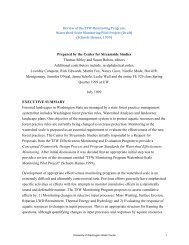Copyright 2012 Aileen M. Echiverri-Cohen - University of Washington
Copyright 2012 Aileen M. Echiverri-Cohen - University of Washington
Copyright 2012 Aileen M. Echiverri-Cohen - University of Washington
Create successful ePaper yourself
Turn your PDF publications into a flip-book with our unique Google optimized e-Paper software.
the letters and ignore the numbers from a stream presented in rapid succession. Following the<br />
stream <strong>of</strong> letters and numbers, participants entered the target letters on the keyboard. If no<br />
second target was present, participants pressed a key labeled 'NO' on the keyboard to ensure that<br />
participants were always entering two responses. Participants started with a practice block <strong>of</strong> six<br />
trials. Participants were given a 1 min break halfway through the AB task.<br />
For the PPI task, participants were oriented to psychophysiological monitoring<br />
procedures. Next, physiological monitoring sensors were attached. Participants heard s<strong>of</strong>t and<br />
loud sounds that were intermittently delivered through the headphones. To help improve<br />
participant attention (Ornitz et al., 1989), participants viewed a silent video that showed various<br />
scenic panoramas, which ran for the duration <strong>of</strong> the task.<br />
Following the assessment at pre-treatment, participants were paid $20/hour for their time.<br />
AB and PPI were repeated again at post-treatment using the same counterbalancing order. At the<br />
end <strong>of</strong> this visit, participants were debriefed on the study purpose and paid $20/hour for their<br />
participation.<br />
Data Reduction<br />
AB. To assess the main AB effect, the percent accuracy <strong>of</strong> T2 identification was<br />
calculated across lags on trials in which T1 was correctly identified (Raymond, Shapiro, &<br />
Arnell, 1992), reflecting the probability <strong>of</strong> correct T2 identification given accurate identification<br />
<strong>of</strong> T1. Accurate identification was defined as correct responding with the correct letters and<br />
order in the RSVP out <strong>of</strong> number <strong>of</strong> trials in the lag. For example, if T1 is "A" and T2 is "J", the<br />
correct responses are "A then J" and not "J then A".<br />
PPI. The EMG responses in each type <strong>of</strong> trial were averaged across the 40 trials. Startle<br />
trials preceded by prepulses reflect a reduction in magnitude produced by a prepulse, with startle<br />
26
















